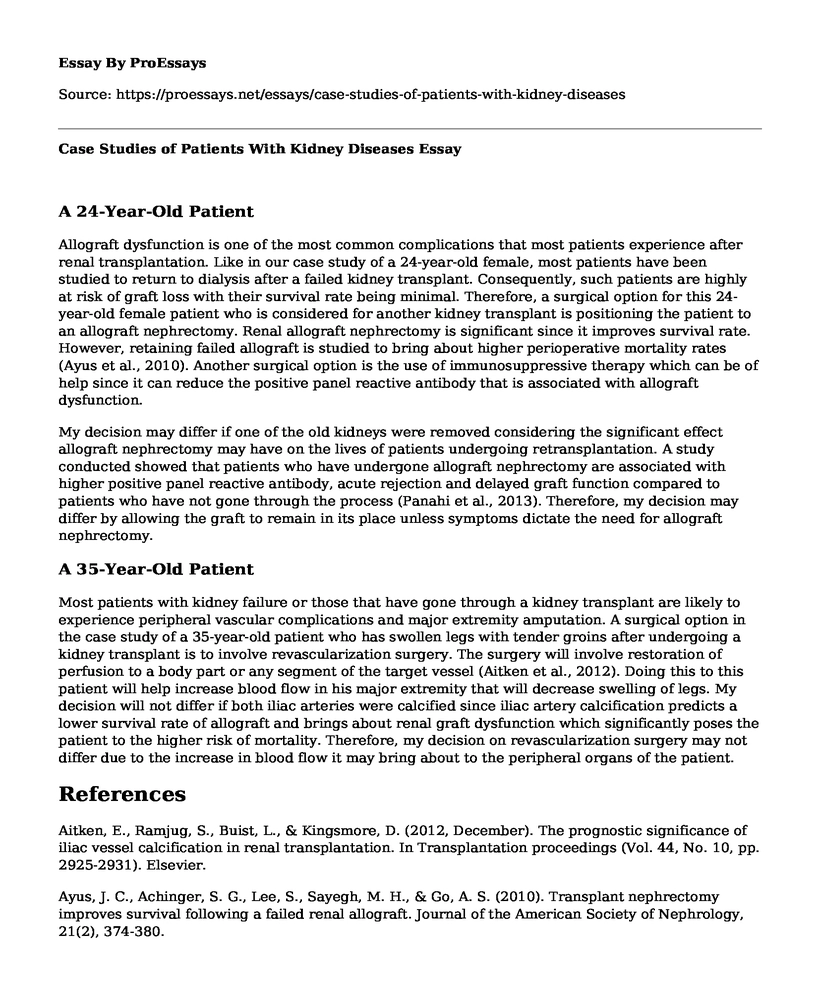A 24-Year-Old Patient
Allograft dysfunction is one of the most common complications that most patients experience after renal transplantation. Like in our case study of a 24-year-old female, most patients have been studied to return to dialysis after a failed kidney transplant. Consequently, such patients are highly at risk of graft loss with their survival rate being minimal. Therefore, a surgical option for this 24-year-old female patient who is considered for another kidney transplant is positioning the patient to an allograft nephrectomy. Renal allograft nephrectomy is significant since it improves survival rate. However, retaining failed allograft is studied to bring about higher perioperative mortality rates (Ayus et al., 2010). Another surgical option is the use of immunosuppressive therapy which can be of help since it can reduce the positive panel reactive antibody that is associated with allograft dysfunction.
My decision may differ if one of the old kidneys were removed considering the significant effect allograft nephrectomy may have on the lives of patients undergoing retransplantation. A study conducted showed that patients who have undergone allograft nephrectomy are associated with higher positive panel reactive antibody, acute rejection and delayed graft function compared to patients who have not gone through the process (Panahi et al., 2013). Therefore, my decision may differ by allowing the graft to remain in its place unless symptoms dictate the need for allograft nephrectomy.
A 35-Year-Old Patient
Most patients with kidney failure or those that have gone through a kidney transplant are likely to experience peripheral vascular complications and major extremity amputation. A surgical option in the case study of a 35-year-old patient who has swollen legs with tender groins after undergoing a kidney transplant is to involve revascularization surgery. The surgery will involve restoration of perfusion to a body part or any segment of the target vessel (Aitken et al., 2012). Doing this to this patient will help increase blood flow in his major extremity that will decrease swelling of legs. My decision will not differ if both iliac arteries were calcified since iliac artery calcification predicts a lower survival rate of allograft and brings about renal graft dysfunction which significantly poses the patient to the higher risk of mortality. Therefore, my decision on revascularization surgery may not differ due to the increase in blood flow it may bring about to the peripheral organs of the patient.
References
Aitken, E., Ramjug, S., Buist, L., & Kingsmore, D. (2012, December). The prognostic significance of iliac vessel calcification in renal transplantation. In Transplantation proceedings (Vol. 44, No. 10, pp. 2925-2931). Elsevier.
Ayus, J. C., Achinger, S. G., Lee, S., Sayegh, M. H., & Go, A. S. (2010). Transplant nephrectomy improves survival following a failed renal allograft. Journal of the American Society of Nephrology, 21(2), 374-380.
Panahi, A., Bidaki, R., Mirhosseini, S. M. M., & Mehraban, D. (2013). Renal allograft nephrectomy: Comparison between clinical and pathological diagnosis. Nephro-urology monthly, 5(5), 1001.
Cite this page
Case Studies of Patients With Kidney Diseases. (2022, Nov 09). Retrieved from https://proessays.net/essays/case-studies-of-patients-with-kidney-diseases
If you are the original author of this essay and no longer wish to have it published on the ProEssays website, please click below to request its removal:
- Canada Health Act Principles Essay Example
- Research Paper on Orem's Self-Care Deficit Nursing Theory: Enhancing Well-Being at Home
- Evidence-Based Practice vs. Research: A Comparison Essay
- Research Proposal: China Facing a Diabetes Crisis: Prevalence & Health Impact
- 4 Steps to Launch a Soap Product for Pandemic Cleanliness - Essay Sample
- Essay on COPD: A Life-Threatening Condition Affecting Millions Worldwide
- Essay on Achieve Well-Being: The Relationship of Psychological & Physical Health







